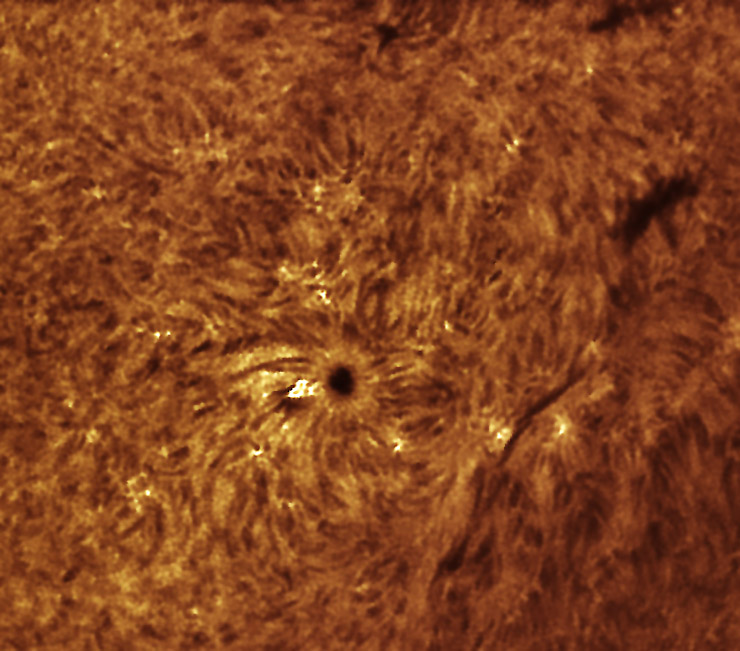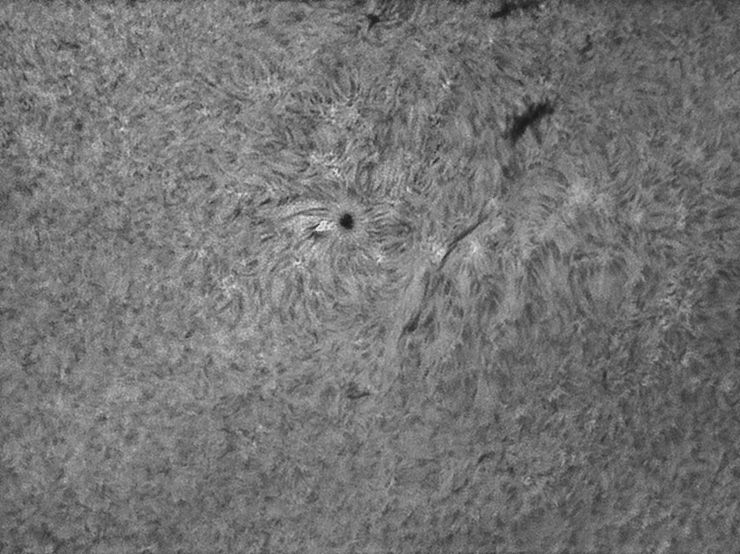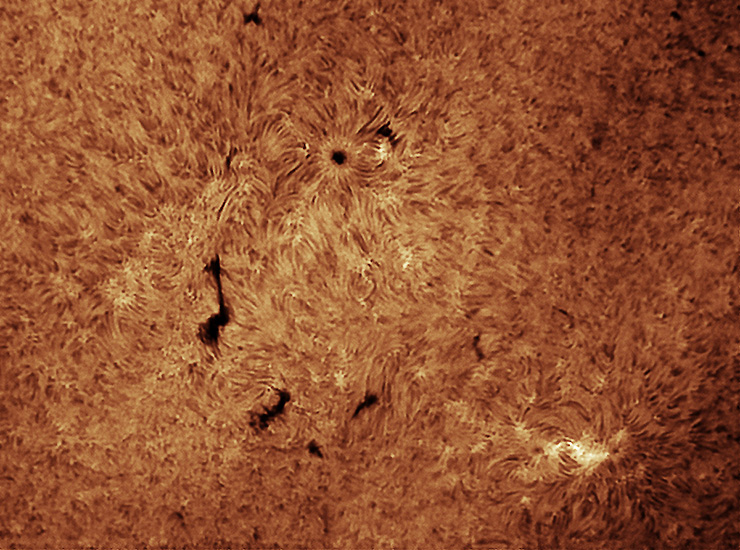Staring at the Sun, 19 :: home :: |
|
8/29/2010: A big Tupperware tub turned on its side makes a useful solar office for the A-P handset and the netbook that drives the camera. The shade inside makes it easy to read the A-P displays and easier to see the notebook screen. However, even more shade is needed. At least a hat, perhaps an umbrella. As threatened, I've tried out some new settings: 12-bit captures, manual control of exposure and gain, telecompressor and barlow. I tried defeating auto controls and manually adjusting gain to +12db, cutting the exposure to 4ms. I also tried boosting exposure to record prominences. I did a little of all this at every image scale. Seeing was very bad. I didn't get to the telescope until 3PM. Large-scale image motion made focusing tougher than it was yesterday. I've used multiple alignment points (6-10) to give Registax a fighting chance to pull good detail out of today's images. All these images are stacks of the best 20 out of 200 twelve-bit captures with the Chameleon, aligned and stacked in Registax, then worked up in Photoshop. With the telecompressor, exposures ran 10-11 ms; at native FL, 14-15ms; and with the Barlow, 90ms. It was a simple matter to defeat auto-exposure, increase gain to 12db, and decrease exposure to 4ms at native FL. It might have been a worthwhile tactic to try in today's poor seeing. Alas, there will be more opportunities.
The Antares 0.5x telecompressor which I bought years ago to work with a guide camera does not come to focus at the end of the PF adapter. But it can be sandwiched inside the adapter, between the camera body and the back of the 1.25-inch snout where it focuses nicely. It either just misses a full disk view or it just delivers one -- be very careful wtih pointing to be sure. Incremental spacing to move it just another few millimeters away from the chip would likely insure that a full-disk view is possible. Either the C/CS extension ring supplied with the camera will do the trick or this will be a good excuse to play with the lathe. The 2nd barlow (the one into which I insert the 1.25-inch adapter for the DSLR) works well for the Chameleon (I haven't tried the screw-in version yet). Note that 200-frame 12-bit AVI's are barely under a gigabyte apiece. They transfer very slowly to the desktop. I'm going to work routinely with 8-bits until I know what I'm doing and can decide when the extra bit-depth is worth the added time and storage.
Try it without double stacking; try the extension ring with the telecompressor; try some longer runs of 8-bit data; start checking out the relationship between gain and noise. And get out there before the air gets so lively.
8/30/2010: Quick look at some fresh data this morning:
Sunspot 1101 is at top, newly emerged 1102 is at lower right. There was A9 - B1 X-ray activity going on when I took this data. Looks like some nifty flare activity involving 1102, to me. This was 500 frames of 8-bit data with the PGR Chameleon, gain set to +12db, shutter to 0.004 seconds through the Barlow amplified LS60DS50, stacked and processed as usual in Registax and Photoshop [note: that shutter speed may be in error; I used the same configuration later in the day and needed exposures of 0.015s with 15db gain]. The air was already pretty lively by the time I got set up and imaging, about 10:30AM. I also tried for some prominence images, but they're not too promising. Need more signal. And I tried the C-mount converter / extension ring with the telecompressor in an effort to get full-disk framing. Too much extension, not enough in-travel. Close, though. I could shorten the B600 tube slightly if it continues to nag at me. After shooting the sequence used to make the image above, I centered and fiddled with focus on 1102 then called for 1,000 images. That exceeded the space available to be allocated. The control program did not react particularly gracefully, and it took so long to get things restarted that I lost the Sun in the treetops. S'OK, I had plenty of bits to work with, and I learned not to do that. If I want that kind of big data to work with, I could stream it straight to the disk or add system memory (which might not be so easy in the Aspire One, I need to look that up). The slowest step in the entire solar imaging workflow is now transferring the data. Not setting up, not focusing, not taking data, not processing. A few minutes for each of those is generous, but simply moving data to the desktop can take hours. That's easy to address though. I've ordered a 250GB USB-powered "pocket drive" from eBay so I can write data to it instead of to the netbook's C: drive. Then I can sneaker-net fresh data en masse to the real computer rather than flinging it through the air. Twenty cents per gig and plenty of uses. Hard to beat that. OK, this much seems clear: 1) focus matters more than 12 vs 8 bit depth; 2) steady air matters more than bit depth, too; 3) 200 frames is enough if the air and focus are dead on. This afternoon's nine imaging trials were done with auto-exposure, 8-bit, 12-bit, manual exposure, and with runs of 200 and 500 frames. The best combination was manual exposure (15db gain, 15ms shutter with barlow extension) and 8-bit, 15fps. I processed each AVI capture without paying any attention to its specs, then picked the best of the lot. It was easy. For all captures, I aligned on a lot of points (15-20), set the quality cut-off at 80%, ran wavelets and FocusMagic. Here's a web-sized look at the best outcome (8-bit pixels, 200 frames, 15fps, 15db gain, 15ms exposure):
There!
|
:: top ::
© 2010, David Cortner





